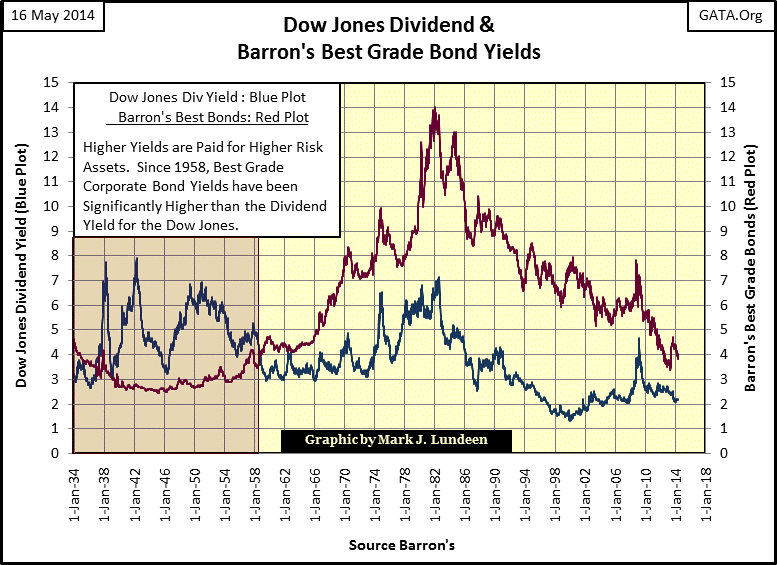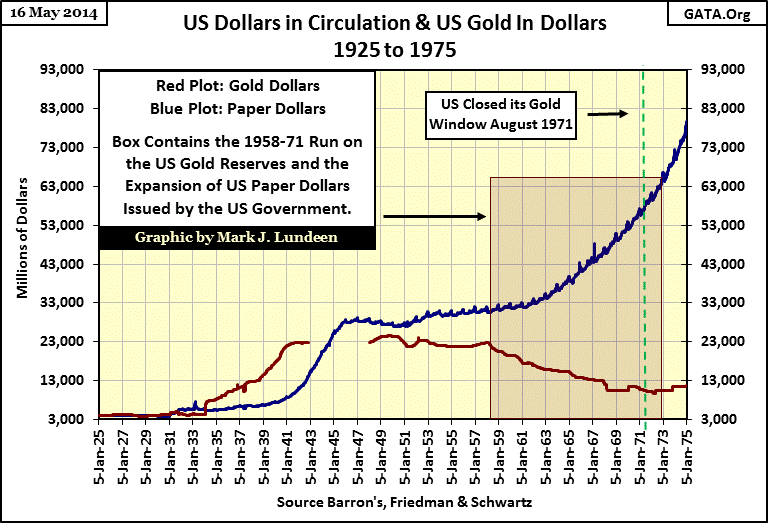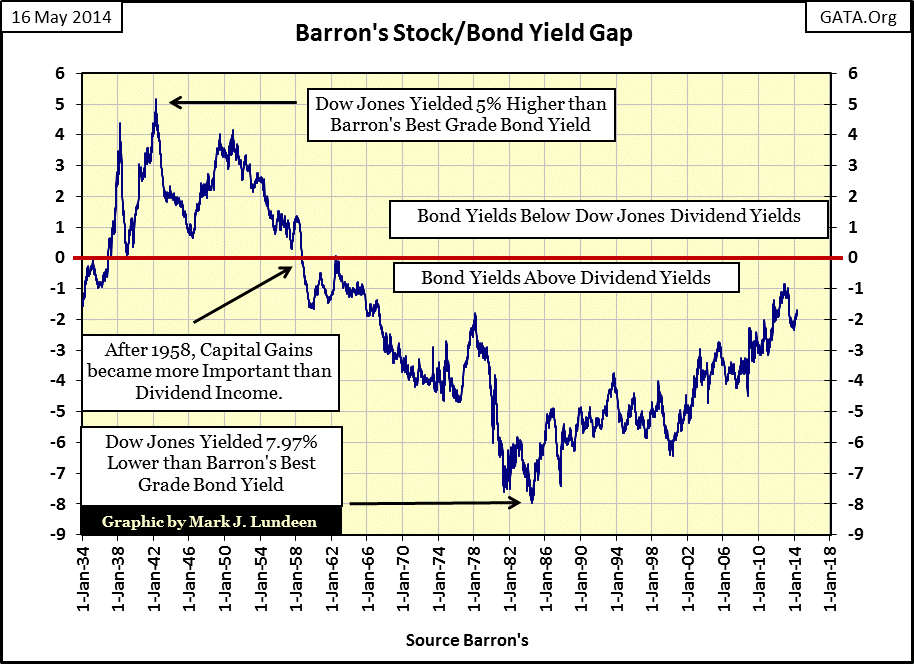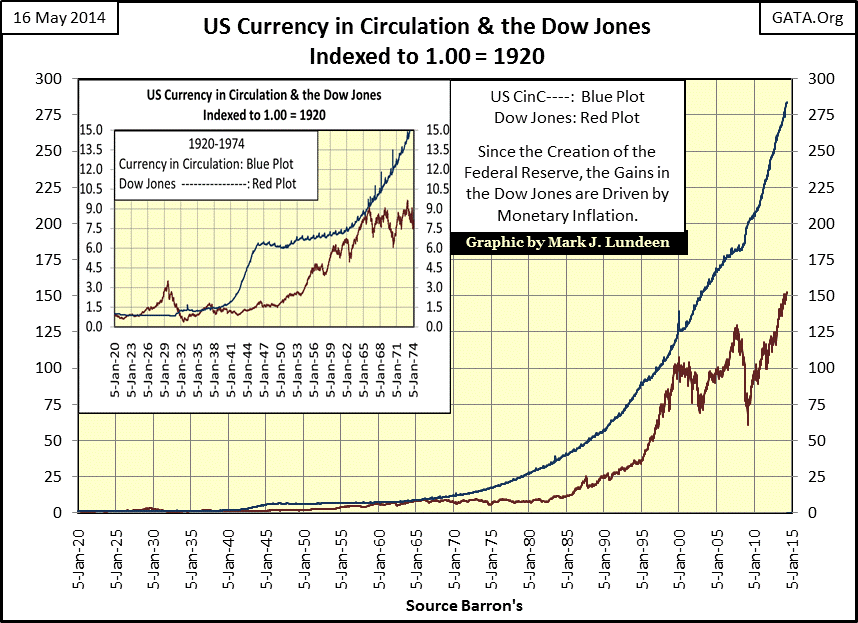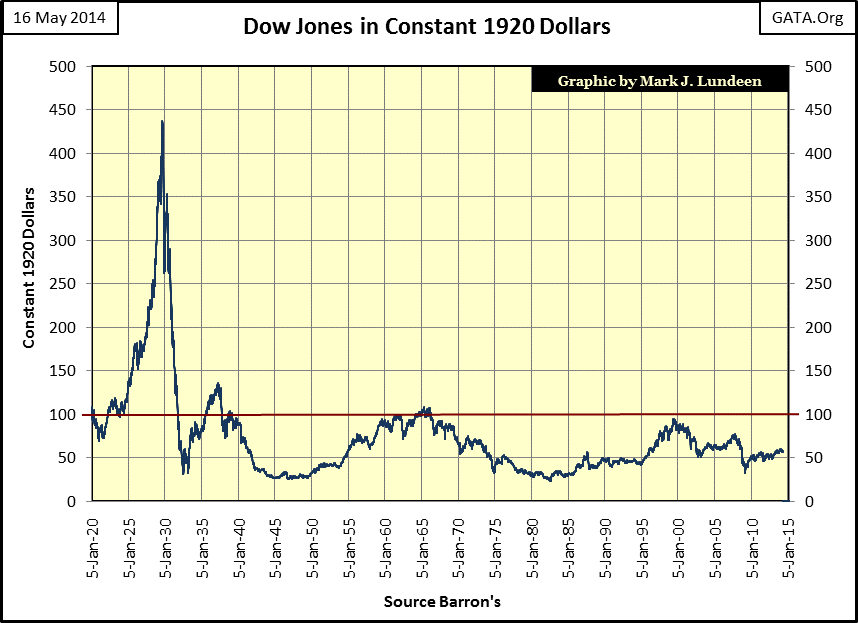Central Banks And Market Valuations
With the fall of the Iron Curtain in 1989 came a surge of expert opinion explaining why the Soviet Union was destined to fail; apparently, communism had made it impossible for the Soviet economy to find the correct prices for goods and services. For example; Soviet agriculture would feed hogs baked bread as it was cheaper than grain; the price of bread was subsidized by the state while unprocessed grain was not. To the management of the agricultural collectives subsidized bread appeared cheaper than grain – but to the real economy it wasn’t. There were gold mines still in operation whose ore reserves were long exhausted. Party policy was one of no unemployment in the USSR – ever. So politically the “policy makers” valued worthless rock as much as valuable ore if that is what it took to meet employment goals. In a system that prohibited for profit enterprise, the old Soviet Union couldn’t afford to shut down a depleted mine. Unfortunately the old Soviet system with its top down heavy-handed approach in getting things done is still much admired by many influential Western academics, members of the media and politicians. The passage of Obamacare and its support by academia and the “mainstream media” is ample proof of that.
The failed economic model of 20th century socialism where nothing supported by the state was ever allowed to fail ultimately collapsed, taking down the Bolsheviks’ revolution with it. When the American economy collapses, its failure will be for the same reasons; the state subsidized its favored industries to the point that failure is not an option, nor is success allowed if solving a problem results in eliminating positions in the government payroll. The Federal Government’s never ending war on poverty and drugs comes to mind. And like the old Soviet Union there is Washington’s constant interference in the economy’s price discovery mechanism supervised by academics who believe they’re smarter than the market.
But where the Soviet system favored their domestic heavy industry, American statists favor finance and the America dollar which is the heart of global commerce. From the standpoint of accumulating power, American socialism is brilliant as it operates under a false flag of capitalism allowing the “policy makers” to claim any success as their own while blaming any failure on an economic system (capitalism) they abandoned decades ago.
“Look, if you've been successful, you didn't get there on your own... If you were successful, somebody along the line gave you some help. There was a great teacher somewhere in your life. Somebody helped to create this unbelievable American system that we have that allowed you to thrive. Somebody invested in roads and bridges. If you've got a business—you didn't build that. Somebody else made that happen.”
Campaign Speech by President Barack Obama on July 13, 2012, in Roanoke, Virginia
As things stand today, four decades after Washington defaulted on the Bretton Woods gold standard, the failure of “capitalism” will soon become apparent to all. This is a sad state of affairs as after Washington’s recent mortgage debacle it should be obvious that the credit crisis WAS NOT the result of private money seeking a return on investment, but the abuse of public credit by Washington’s political class and Wall Street banks subsidized with cheap credit and granted a license to kill time tested historical rules of prudence in the creation of credit. But the key to the mortgage debacle was its support by academics. People have a natural suspicion of politicians and bankers, but when a respected academic seeking neither votes nor personal gain, but only “the truth” supports “innovation” in finance – watch out!
"Innovation has brought about a multitude of new products, such as subprime loans and niche credit programs for immigrants. With these advances in technology, lenders have taken advantage of credit-scoring models and other techniques for efficiently extending credit to a broader spectrum of consumers. These improvements have led to rapid growth in subprime mortgage lending . . . fostering constructive innovation that is both responsive to market demand and beneficial to consumers."
- Alan Greenspan (At the Federal Reserve System’s Fourth Annual Community Affairs Research Conference, Wash D.C. April 8, 2005)
What nonsense! Writing quarter million dollar mortgages for “subprime borrowers” with zero prospects of servicing their debt for the next thirty years was always an imbecilic idea that could only have resulted in disastrous defaults and collapsing market valuations. But the 21st century American political and financial elite don’t see it that way; not when the Federal Reserve System can “monetize” their credit debacles to support “stability” in the financial markets.
This perversion of market valuations didn’t just happen, we find ourselves at the end of a road that began a long time ago, and we’re now in a time and place where rising prices don’t necessarily increase market values.
“Central banks are now so heavily influencing asset prices that investors are unable to ascertain market values.”
- Kevin M. Warsh: Former Federal Reserve Governor. Comments made to the Stanford University Institute for Economic Policy Research, 25 Jan 2012.
Former Fed Governor Warsh’s comments aren’t just central bank psychobabble but a troubling phenomenon observable in blue-chip companies’ dividend and bond yields. Long ago investors understood that stocks and bonds offering high yields were investments that had risks lower yielding investments did not. We can see this phenomenon at play in the chart below (Red Box) plotting the dividend yield for the DJIA’s thirty blue-chip stocks and the yield for Barron’s Best Grade Bond Average.
As these stocks and bonds are both issued by high quality blue chip companies, why do the yields between dividends (Blue Plot) and bonds (Red Plot) vary so greatly? Because bonds are debt contracts offering “fixed income” for a specified period of time. Before the Obama administration intervened to prevent the failure of General Motors and Chrysler in 2009, all companies whose finances had fallen to the point where they couldn’t pay their bond holders’ interest payment as scheduled were legally bankrupt and subject to liquidation to satisfy their debts. Because there were legal guarantees protecting bond holders’ principal and interest income, the financial market offered lower yields to bond holders, or did until 1958.
Stock dividends, on the other hand, are not a legal requirement on the company, but a profit sharing program to shareholders who legally own the company. Dividend distributions are not “fixed income” but can be increased or even eliminated entirely by a company’s management with no legal recourse available to the shareholders. As dividend income is not guaranteed it has a higher risk than income from a bond. That is why the market demanded higher dividend yields from a blue chip company than its corporate bonds’ offered, or did until 1958.
What happened in 1958? The global currency market finally recognized that the United States government’s monetary policy was inflationary and Washington was never going to honor its monetary-treaty obligation limiting its issue of paper money to no more than thirty five paper dollars per ounce of gold in the US Treasury’s gold reserves. In 1958 the expanding supply of paper dollars in circulation caused a run to begin on US gold reserves that only ended in August 1971 when President Nixon refused to honor the Bretton Woods Agreement requiring the United States to exchange American paper dollars for gold.
One of my pet peeves frequently encountered in gold-market commentary is the claim that President Nixon was responsible for terminating the Bretton Woods gold standard in 1971. While technically this may be true, it omits the fact that “Nixon closed the gold window” only after a thirteen year run on the US Treasury’s gold reserves that began under President Eisenhower. This is evident in the chart above and the table below from the government’s own data published in Barron’s for decades. By the time Nixon began his presidency in January 1969, the US Treasury and Federal Reserve had already issued 170 paper dollars for each ounce of US gold in the US Treasury. No wonder foreign central banks wanted to exchange their paper US dollars for US gold at the official rate of $35 paper dollars per ounce, and why Washington terminated the final link to the gold standard before the Treasury’s supply of monetary gold was completely drained.
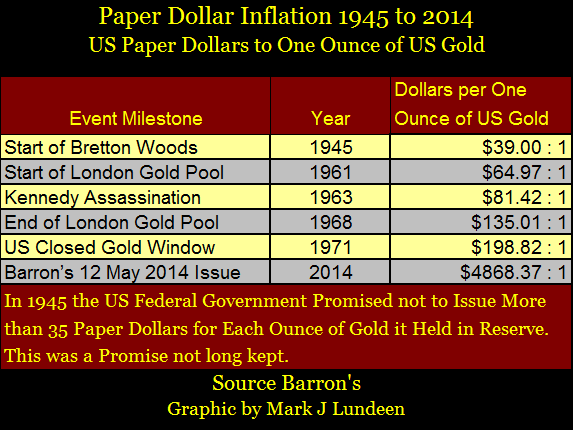
Since August 1971 the inflationary gales blowing from Washington have only grown stronger; currently there are 4,868 paper dollars in circulation for each ounce of gold the US Treasury claims to hold. This inflationary policy has had profound impact on asset valuation as it provides funding to politicians for ill-conceived political schemes such as guaranteeing sub-prime mortgages, and the means for Wall Street to create phantom economic wealth which they market to fiduciaries and individuals. In 2014 wealth defined in dollars is fragile, as members of the Federal Reserve Open Market Committee are well aware. When best-grade bond yields once again rise up to where they were during the 1990’s High-Tech Bubble (two charts up / 6% - 9%) there will be a panic on Wall Street.
Below is a chart plotting the Barron’s Stock/Bond Yield Gap, a credit spread using the Dow Jones dividend and Barron’s Best Grade Bond yields seen two charts up. Long ago (before 1958) investors used this spread to ascertain values in the stock market; whether stock values were cheap and thus an opportune time to buy, or already fully priced and at risk of an imminent correction. Since dividend payouts were riskier than fixed income from best grade bonds, investors demanded stock dividend yields that were higher than bond yields. However when the yield spread for the Dow Jones increased to more than 4% above the yield of Barron’s Best Grade Bonds, the stock market was seen to be near a bear market bottom, so presented investors a compelling bargain.
Barron’s Stock/Bond Gap could also be used to ascertain when the stock market was fully valued and due for a bear market decline: when the spread between dividends and bond yields had declined to 1% or less. It’s only logical that when an investor can receive as much income from risk free bonds as from riskier dividend income, the shares of a blue-chip company are overpriced and should be sold until dividend yields rise – as a result of declining share prices. This focus on income from stocks and bonds may seem strange today, but when the dollar really was as good as gold, this was how the majority of investors approached the financial markets: saving 10% of their income and reinvesting the 4-6% annual dividend return for thirty years funded a secure retirement. Because of monetary inflation this can no longer be done today.
After 1958 investing in terms of yields became obsolete and inflationary-capital gains became the primary motivation for entering the stock market. As far as investing in the bond market where both principal and fixed income are consumed by inflation, since World War Two they have become a multi-trillion dollar bad habit that money managers can’t seem to break. And using Barron’s Stock/Bond Yield Gap for market insights in today’s market – forget about that; it’s as obsolete as $35 gold. How could it not be? It’s widely acknowledged that bond and stock valuations (and so their yields) are constantly manipulated by the Federal Reserve, not the free market. But Barron’s still publishes it weekly (thanks a lot guys!), and I keep the series current.
And then the stock market isn’t all that investment advisors would have us believe either as since 1920 monetary inflation has greatly exceeded the gains in the Dow Jones. After subtracting capital gains taxes and commissions, the returns from the stock market have been even less. The chart below illustrates a continuing inflationary scandal that has gone on for decades with little public awareness.
Below is a chart plotting the Dow Jones in constant 1920 dollars. This plot is constructed by taking the published closing price of the Dow Jones (not the indexed value [Red Plot] above) divided by the indexed value of CinC as seen above (Blue Plot).
Dow Jones Published Price / Indexed Value of CinC
The Dow Jones may have closed at 16,715.44 this week, a new all-time high in nominal dollar terms, but when deflated using CinC below, we see how in 1920 dollars it is only $57.96! As the Dow Jones closed at 108 in the first week of January 1920 a case can be made that this week’s new all-time high is actually a 47% decline from January 1920.
Pricing the Dow Jones or anything else in “constant 1920 dollars” may seem like nonsense to many, but then all too many people of influence take seriously Washington’s ridiculous statistics for GDP, unemployment and inflation. I blame their blindness on their education. Like citizens of the Soviet Union in 1989 I expect we’ll all wake up one day and realize that without a doubt current statistics from Washington are only reported fabrications of a world that has never existed except in the minds of academics that control Washington’s statistical apparatus.
I think former Federal Reserve Governor Kevin Warsh has a point; central banks with their ever expanding monetary inflation are manipulating asset valuations to mask the unintended economic consequences of their debauched currencies and failed policies. Though he didn’t exactly say that; that is what he meant. And what “unintended consequences” would that be? That a financial market valued in a currency that is essentially worthless can ultimately only disappoint investors. So what if currently gold can’t stay above $1350 or silver $20; these prices in fiat dollars are meaningless. Right now the smart thing to do is stop thinking of gold and silver in terms of dollars, and start thinking of gold in terms of ounces and silver in terms of pounds of metal you can purchase.
Mark J. Lundeen
16 May 2014






